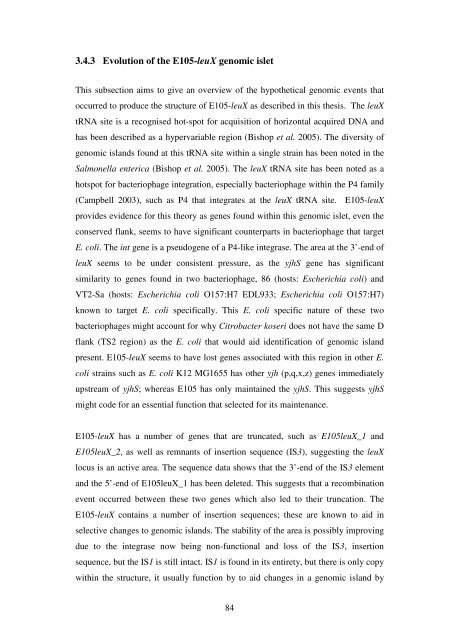5 The role of quorum-sensing in the virulence of Pseudomonas ...
5 The role of quorum-sensing in the virulence of Pseudomonas ...
5 The role of quorum-sensing in the virulence of Pseudomonas ...
Create successful ePaper yourself
Turn your PDF publications into a flip-book with our unique Google optimized e-Paper software.
3.4.3 Evolution <strong>of</strong> <strong>the</strong> E105-leuX genomic islet<br />
This subsection aims to give an overview <strong>of</strong> <strong>the</strong> hypo<strong>the</strong>tical genomic events that<br />
occurred to produce <strong>the</strong> structure <strong>of</strong> E105-leuX as described <strong>in</strong> this <strong>the</strong>sis. <strong>The</strong> leuX<br />
tRNA site is a recognised hot-spot for acquisition <strong>of</strong> horizontal acquired DNA and<br />
has been described as a hypervariable region (Bishop et al. 2005). <strong>The</strong> diversity <strong>of</strong><br />
genomic islands found at this tRNA site with<strong>in</strong> a s<strong>in</strong>gle stra<strong>in</strong> has been noted <strong>in</strong> <strong>the</strong><br />
Salmonella enterica (Bishop et al. 2005). <strong>The</strong> leuX tRNA site has been noted as a<br />
hotspot for bacteriophage <strong>in</strong>tegration, especially bacteriophage with<strong>in</strong> <strong>the</strong> P4 family<br />
(Campbell 2003), such as P4 that <strong>in</strong>tegrates at <strong>the</strong> leuX tRNA site. E105-leuX<br />
provides evidence for this <strong>the</strong>ory as genes found with<strong>in</strong> this genomic islet, even <strong>the</strong><br />
conserved flank, seems to have significant counterparts <strong>in</strong> bacteriophage that target<br />
E. coli. <strong>The</strong> <strong>in</strong>t gene is a pseudogene <strong>of</strong> a P4-like <strong>in</strong>tegrase. <strong>The</strong> area at <strong>the</strong> 3’-end <strong>of</strong><br />
leuX seems to be under consistent pressure, as <strong>the</strong> yjhS gene has significant<br />
similarity to genes found <strong>in</strong> two bacteriophage, 86 (hosts: Escherichia coli) and<br />
VT2-Sa (hosts: Escherichia coli O157:H7 EDL933; Escherichia coli O157:H7)<br />
known to target E. coli specifically. This E. coli specific nature <strong>of</strong> <strong>the</strong>se two<br />
bacteriophages might account for why Citrobacter koseri does not have <strong>the</strong> same D<br />
flank (TS2 region) as <strong>the</strong> E. coli that would aid identification <strong>of</strong> genomic island<br />
present. E105-leuX seems to have lost genes associated with this region <strong>in</strong> o<strong>the</strong>r E.<br />
coli stra<strong>in</strong>s such as E. coli K12 MG1655 has o<strong>the</strong>r yjh (p,q,x,z) genes immediately<br />
upstream <strong>of</strong> yjhS; whereas E105 has only ma<strong>in</strong>ta<strong>in</strong>ed <strong>the</strong> yjhS. This suggests yjhS<br />
might code for an essential function that selected for its ma<strong>in</strong>tenance.<br />
E105-leuX has a number <strong>of</strong> genes that are truncated, such as E105leuX_1 and<br />
E105leuX_2, as well as remnants <strong>of</strong> <strong>in</strong>sertion sequence (IS3), suggest<strong>in</strong>g <strong>the</strong> leuX<br />
locus is an active area. <strong>The</strong> sequence data shows that <strong>the</strong> 3’-end <strong>of</strong> <strong>the</strong> IS3 element<br />
and <strong>the</strong> 5’-end <strong>of</strong> E105leuX_1 has been deleted. This suggests that a recomb<strong>in</strong>ation<br />
event occurred between <strong>the</strong>se two genes which also led to <strong>the</strong>ir truncation. <strong>The</strong><br />
E105-leuX conta<strong>in</strong>s a number <strong>of</strong> <strong>in</strong>sertion sequences; <strong>the</strong>se are known to aid <strong>in</strong><br />
selective changes to genomic islands. <strong>The</strong> stability <strong>of</strong> <strong>the</strong> area is possibly improv<strong>in</strong>g<br />
due to <strong>the</strong> <strong>in</strong>tegrase now be<strong>in</strong>g non-functional and loss <strong>of</strong> <strong>the</strong> IS3, <strong>in</strong>sertion<br />
sequence, but <strong>the</strong> IS1 is still <strong>in</strong>tact. IS1 is found <strong>in</strong> its entirety, but <strong>the</strong>re is only copy<br />
with<strong>in</strong> <strong>the</strong> structure, it usually function by to aid changes <strong>in</strong> a genomic island by<br />
84














